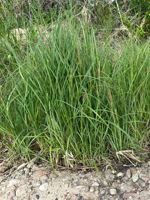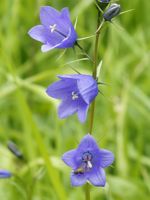Mon-Fri 9am - 5pm Mountain time
Harebell vs Wheat Sedge
Carex atherodes
Campanula rotundifolia
CUSTOM GROW
NOT AVAILABLE THIS SEASON - MIGHT RETURN
Wheat Sedge is a native perennial sedge commonly found in wetlands, ditches, and along shorelines. It thrives in saturated soils, spreading by rhizomes to form large colonies that stabilize both soils and shorelines. This makes it valuable for wetland and riparian plantings.
Its distinctive, wheat-like seed spikes add seasonal character while providing food for waterfowl, and its dense clumps supply cover and nesting habitat for birds and small animals. Together, these traits make Wheat Sedge an important species for enhancing biodiversity and supporting healthy wetland ecosystems.
Harebell is a native perennial wildflower known for its bell-shaped, blue-violet flowers. The noddling blooms occur in clusters at the top of slender stems. Blooming in bursts from summer to fall, the flowers attract pollinators such as butterflies, bees, and hummingbirds.
Regular deadheading encourages additional blooms, extending its floral display through the season. Harebell prefers areas with cooler summer climates and does poorly in those that get too hot and humid. It is well suited for native wildflower gardens, pollinator gardens, and naturalization projects.

